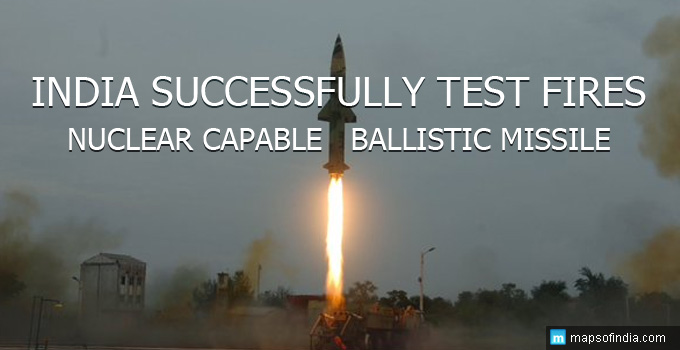In spite of being a responsible country, India has to put resources and material to meet challenges from ravenous and menacing neighbours like Pakistan. The recent successful test-firing of surface-to-surface ballistic missile Prithvi-II from the Integrated Test Range (ITR) at Chandipur in Odisha should be seen in this context. Prithvi-II with a strike range of 350 km is a tactical missile and is capable of carrying 500kg to 1,000 kg of warheads. Armed with advanced inertial guidance system, the indigenously developed missile has the capability to hit the target with precision. It can be taken close to the forward line over any kind of terrain and deliver conventional or tactical warheads deep into enemy territory. What is, moreover, special about the nine-metre-tall single-stage liquid-fuelled missile is that after reaching an altitude of nearly 30 km, the missile stops climbing and dives at the target at an 80 degree angle. And this is the reason the missile is feared most by the enemy. It was first test-fired in 1988 and inducted into the armed forces in 2003.
How significant is Prithvi missile for defence forces?
Built by the Defence Research and Development Organisation (DRDO), the indigenously developed missile has three variants: Prithvi-I, Prithvi-II and Prithvi-III. Prithvi-I and Prithvi-II are based on liquid fuels. The third variant of Prithvi has more than 750-km range and is launched from a transporter-erector-launcher vehicle. Its high accuracy enables it to hit enemy target effectively thereby, making it a dependable battlefield weapon. The specially formed strategic force command (SFC) of the Indian army is in possession of this short-range tactical weapon. Prithvi has the Air force and the Naval version too. While the army version is capable of delivering a payload of 1000 kg, the Air force has a payload of 500 kg. It has been designed with an aim to neutralize key strategic and defence targets of the enemy. It can hit radar, missile launching pads and concentration of army troops. It has a capability to evade the intercepting missiles using deception measures. The Prithvi-III uses two-stage-liquid and solid propulsion system. This system is used by the Indian Navy after being successfully test fired on board INS Subhadra and INS Rajput. With constant improvement in its speed and precision quality, Prithvi missile has become a weapon of vast importance.
Defence Preparedness of India
Given that India has a neighbor which has for almost seven decades perpetuated a security threat to the country, New Delhi requires not only high-level of awareness, it also needs weapons of high-quality and precision to tear asunder enemy’s arsenal placement mechanism. That means, India needs an optimal level of defence preparedness and for this to happen it will have to manufacture weapons within the country. But sadly, nothing significant has happened on this front. And this is the reason why the armed forces are saddled with nearly 30 percent of obsolete technology. The Indian army is armed entirely with obsolete technology. In March 2012, the then Army Chief General V K Singh had put on record by saying that “97 per cent of army’s air defence inventory was obsolete.” On the ground, nothing much has changed. In this respect, the recent test-firing of Prithvi-II missile should be seen a major shot in the arm for the armed forces.




